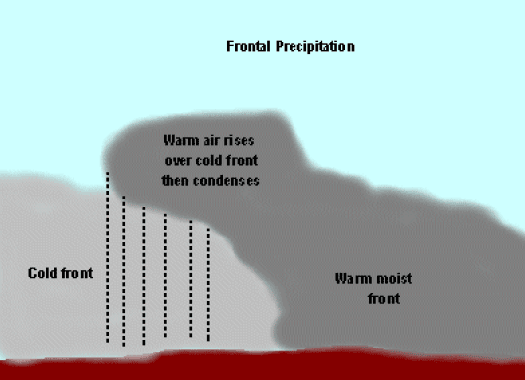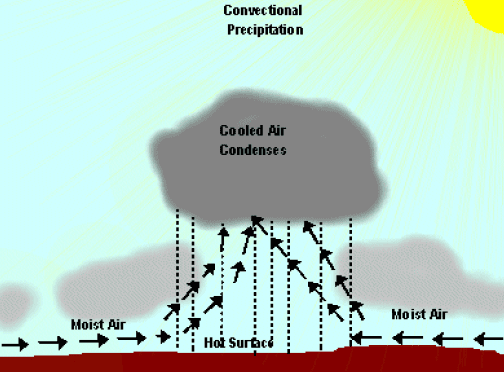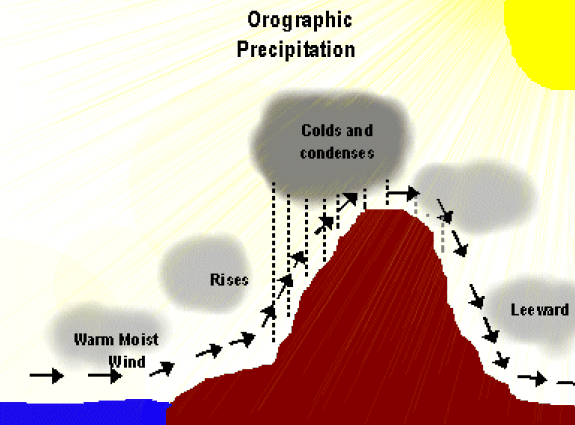Table of Contents
Introduction
Precipitation can either be liquid or solid form. Those of liquid include rain and drizzle, while those of solid can be of the more diverse way depending on the hydrological mechanisms. They can fall as snow, hail, snow and ice pellets, and ice crystals. The knowledge of rainfall is significant in the understanding of soil moisture and general environmental analysis and aviation aerodynamics. In this case, the study of precipitation is hence importance in hydrolysis and airline industry. Hydrologists in the aviation sector are more often interested in investigating how much precipitation occurs and when and where it fall. This is of much importance as it helps in the prediction of weather for air travels. According to Borzenkova (2011) precipitation in the water in liquid or solid state falling from clouds or those that are formed on the earth’s surface and ground objects due to condensation of airborne water vapor. Additionally, it is that portion of the hydrological cycle in in which the atmospheric water vapor is concentrated, making water droplets sufficiently large that the gravity causes them to fall to earth. Based on the mechanisms of cloud formation and structure, precipitation can be temperate-intense (uninterrupted) and produced mainly from stratocumulus clouds, cumulonimbus, and from stratus clouds. Those type of snow formed on the earth’s surface are referred to as ground hydrometeors, and they comprise of glaze, hard frost, hoarfrost, and dew (Borzenkova, 2011). This paper, therefore, describes the meaning of precipitation, main types, the causes of precipitation, and how it impacts the aviation industry. In this case, the paper will provide a comprehensive analysis and understanding of precipitation and how it formed based on the mechanisms of cloud development and structure.
Recent scholars have argued that clouds that produce thunderstorms and therefore torrential rains and hail are called cumulonimbus. In these case, these clouds are often bridged an enormous temperature range as argued by Michaelides (2008). Therefore, in the powerful thunderstorm where updrafts exceed 10 m/s, raindrops tend to be lifted up above the freezing level. In this case, some of the drops freeze to produce ice particles, while others remain in liquid form despite the below-freezing temperatures. Besides, in this region of cloud, the ice particles and liquid water drops will collide with each other to form to the ice enlarging the size of ice particles resulting from substantial precipitation (Michaelides, 2008).
Cause of Precipitation
According to Elizabeth and Kitchen (2011), precipitation is a type of water that originates from the sky and then falls on the earth’s surface. Its formation begins in the cloud as mentioned earlier. When water droplets located within the cloud gets cooled, and from large sizes, the cloud cannot support them, the water start, under the force of gravity, falls on the ground. If those big water droplets or ice do not re-evaporate as they fall below the earth’s surface, they reach the ground as precipitation in different forms depending on the hydrological mechanism (Elizabeth and Kitchen, 2011). Separately, when water vapor is more below the cloud, and the updrafts is stronger, the water vapor will eventually condense into cloud water or ice particles; hence precipitation will form within the cloud.
Looking at the study conducted Rhoda (2013) on Geo-Mexico shows that in Mexico precipitation falls as rain though snowfalls and for it to happen air must acquire moisture. In this case, warm air will absorb moisture through evaporation from nearby bodies of water. This will make the air to rise because the temperature is relative humidity. As it rises, it cools because the relative humidity of the air rises and when it reaches 100%, water vapor will condense out of the air to form clouds. As the cloud forms, water molecules coalesce until each drop are thick that the cloud cannot contain and eventually falls out of the cloud as precipitation (Rhoda, 2013).
Form of Precipitation
As aforementioned, there are many types of precipitation depending on the existing mechanisms of cloud formation and structure. According to Garrison (2004), snow in warm parts of the world is always rain or drizzle. However, in colder regions, precipitation may fall as snow or ice. The most common types of precipitation include Liquid precipitation such as rain, drizzle, freezing rain and Solid precipitation such as snow, ice fog, and frost (Garrison, 2004).

Drizzle
It is a nice sprinkle of small and rather uniform water drops that have a diameter of 0.02 inch. The diameter is so small in the sense that they seem to float in the air and adopt the abnormalities of the air motion. For a water droplet to be a drizzle, they must only be small and also many in number. When drizzle freezes on getting in touch with the ground or other materials, it is called freezing drizzle.
Rain
It is a precipitation of liquid water in which the drops are larger than in drizzle in the sense that they tend to reach down and cannot float in the air. On some occasion, the size of the rain precipitation may be of drizzle size, but they are then few and far between. The drops of water are mostly 0.5 inches a diameter, and this distinguishes them from the drizzle. It is usually reported to in three intensities, light for rates of fall from a trace to 0.1, moderate from 0.11 to 0.3 and torrential rains over 0.3.Freezing rain
In this class of precipitation, rain drops fall through the cold are air near the surface do not change to ice in the air but transform to ice when they touch the cold surface. When raindrops pass through cold air layers, they become supercooled, and freezing rain or supper-cooled drizzle occur. Freezing rain falls in the liquid state but freezes upon impression to form a covering of glaze on the ground and exposed to objects. Then after, the frozen raindrops form a very wet and almost transparent “glazed” film that is dangerous for pedestrian and even air transport.
Hail
They are round pellets of ice larger than 5 millimeters in diameter. Hailstorms are formed only from cumulonimbus clouds during thunderstorms. As described by Garrison (2004), they start as ice pellets inside a cold region of a cloud. Then strong updrafts in the cloud carry the hailstone up and down through the cold part several times. For this reason, every time the hailstone goes through the cold region, a new layer of ice forms around the hailstorms. This will eventually make the hailstorms heavier to fall on the ground.
Sleet
When rain falls through a layer of air below 00C, the freezing point of water. In this case, as they fall, the raindrops freezes into solid particles of ice. This makes the ice to be smaller than 5 millimeters is a diameter called sleet.
Snow
This is a precipitation of solid water. It mainly occurs in the form of branched hexagonal crystals resulting from condensation. It is also described as the most common kind of precipitation of water vapor directly to ice. Group of ice crystals from snowflakes in the shape of hexagonal combines and their diameter differ depending on the air temperature. In this case, when the temperature is high, the flake is bigger, and this makes the biggest chips to fall with heavy precipitation. According to the research conducted by the United States Department of Agriculture and Soil Conservation Service (2001), a single ice crystal can reach the ground, but usually, some coalesce and fall as snowflakes. On the other hand, snows falls from the cloud of different shapes, mostly strato-cumulus, high stratus, and cumulonimbus, during the cold periods of the year.
Types of Precipitation
As argued by Sievert (2005), water vapor in the atmosphere is the most necessary factor in the formation of precipitation; however, there exists other the different mechanism for the formation of precipitation. They include lifting and cooling, condensation, and droplet formation. In lifting and cooling, the air mass is lifted to the higher altitudes, which causes cooling to the air. After enough cooling, until dew point is reached, condensation occurs in the form of clouds. This will turn water vapor into liquid droplets. The after, the growth of droplets is necessary of the liquid water present in a cloud is to reach the ground against the lifting mechanisms of air. The lifting in precipitation can occur in three ways that are also termed as the main types of snow. They include the following depending upon the way in which the air is lifted and cooled so as to cause precipitation (Rodgers, and Streluk, 2007).
Cyclonic Precipitation
In this type of precipitation, it caused by lifting of the air mass due to the pressure difference. A cyclone is described as a region of low pressure with a counter-clockwise circulation of the air around it, usually inward, toward the center. This type of precipitation can be grouped into frontal and non-frontal. Non-frontal precipitation occurs in any barometric of barometric depression. In this case, the lifting of the air is caused by the horizontal convergence of the air flowing from an area of higher pressure to the low-pressure area. Alternatively, in the case cold front, a denser air mass lifts the warm moisture ahead if it, when it rises, it cools and it moisture condenses to produce clouds hence precipitation. On the other hand, frontal precipitation occurs from airlifting to warm and moist air on one side of the frontal surface over colder, denser air on the other side. In this case, a front maybe warm or cold relying upon whether the dynamic or passive accent of hot air mass over cold air mass as shown in Figure 1.
Figure 1: Frontal Precipitation

Source: Rodgers and Streluk 2007
Convection precipitation
This lifting precipitation is caused by the natural rising of warmer, lighter air in colder, denser environments. Commonly, this type of precipitation tends to happen in temperate tropics in which on a hot day, the ground surface become heated, causing the warmer air to lift up as the colder air comes to take its place as shown in Figure 2 below. This will make the vertical air currents to develop massive velocities that make the convective precipitation occur in the form of showers of high intensity within a short period.
Figure 2: Convection Precipitation

Source: Rodgers and Streluk 2007.
Orographic precipitation
Figure 3 shows how orographic precipitation occurs when air masses that strikes some natural topographic barriers such as mountains cannot move forward and thus rises, causing condensation a precipitation. Separately, orographic barriers are often supplied the lifts to set off the storm. For this reason, the precipitation will be heavier on the windward slopes, with rain shadows on leeward slopes.
Figure 3: Orographic Precipitation

Source: Rodgers and Streluk 2007.
As the air rises, it cools because of the higher elevation results in cooler temperatures. Additionally. The side of the mountain (leeward) receives little precipitation in the sense that as the air moves downward, it collects moisture along from the ground through evaporation (Rodgers and Streluk, 2007).
How Precipitation Affects the Aviation Industry
Up to modern times, recent studies indicates that aviation is among the industry affected by different forms of precipitation. This is because weather changes affect air transport as communication can be lost. According to Cova and Conger (2004), extreme weather hazards such as hailstorms, snow, icebergs have affected not only the aviation industry but also transport sector as a whole. This is because, most of these forms of precipitation are tough to predict and might lead to dramatically reduced network serviceability, increased cost, and decrease safety (Cova and Conger, 2004). Looking at the rain, snow, and ice, in particular, they are the common weather hazards that affect air transportation in the sense that they compromise the visibility and quality of the airport surface. Ice in specific affects the aircraft within the meaning that it has effects on the lifts as well as sea travel because it creates sea obstacles.
Finally, because snow tends to have the higher moisture content as temperatures near the freezing point, it will fall on the ground affecting air runway. Recent research indicates that snow on the runway leads to snow-related aircraft mishaps. Consequently, Cao, Wu, and Zu (2014) argue that rainfall is one of the important meteorological factors to threat aircraft flight safety. In the further argument, they mention that raindrop impingement, splash back and flow of the formed water film upon the lifting surfaces efficiently degrade aircraft aerodynamic performance resulting to extreme aviation accidents (Cao, Wu, and Zu, 2014).
- Borzenkova, I. I. (2011). Types and Characteristics of Precipitation. Hydrological cycle, Vol. II.
- Cao, Y., Wu, Z., and Xu, Z. (2014). Effects of rainfall on aircraft aerodynamics. Aerospace science, DOI: 10.1016/j.paerosci.2014.07.003
- Cova, T.J., and Conger, S. (2004) Transportation hazards, in Handbook of Transportation Engineering, M. Kutz (ed.), McGraw Hill, New York, pp. 17.1-17.24.
- Elizabeth, R., and Kitchen, C. (2010). Precipitation: What it is and What Causes It? Bright hub.
- Garrison, S. (2004). Precipitation: North Carolina Testing Program.
- Michaelides, S. (2008). Precipitation: Advances in measurement, estimation, and prediction. Berlin: Springer.
- Rhoda, R. (2013). The three main causes of precipitation in Mexico. Geo-Mexico, the geography and dynamics of modern Mexico. ISSN: 1927-1549.
- Rodgers, A., & Streluk, A. (2007). Precipitation. Chicago, Ill: Heinemann Library.
- Sievert, T. (2005). Precipitation. Mankato, Minn: Capstone Press.
- The United States Department of Agriculture and Soil Conservation Service. (2001). Precipitation: Hydrology training series. Module 102.

